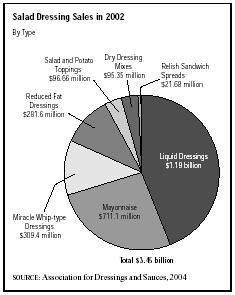SIC 2035
PICKLED FRUITS AND VEGETABLES, VEGETABLE SAUCES AND SEASONINGS, AND SALAD
DRESSINGS
This category covers establishments primarily engaged in pickling and brining fruits and vegetables and in manufacturing salad dressings, vegetable relishes, sauces, and seasonings. Establishments primarily engaged in manufacturing catsup and similar tomato sauces are classified in SIC 2033: Canned Fruits, Vegetables, Preserves, Jams, and Jellies, and those packing purchased pickles and olives are classified in wholesale or retail trade. Establishments primarily engaged in manufacturing dry salad dressing and dry sauce mixes are classified in SIC 2099: Food Preparations, Not Elsewhere Classified.
NAICS Code(s)
311421 (Fruit and Vegetable Canning)
311941 (Mayonnaise, Dressing, and Other Prepared Sauce Manufacturing)
Diversified multibillion dollar companies such as H.J. Heinz Company, Kraft General Foods, Inc., and Unilever Best Foods North America were the major producers of pickles, sauces and seasonings, and salad dressings in the 2000s. However, small, regional independents often accounted for many familiar products.
The industry reflected the trends that were influencing other food processors—consumers were concerned with healthier eating and developed the taste for exotic flavors and ethnic cuisine. Retail sales of sauces and dressings grew 2.7 percent to $7.02 billion in 2002, according to the Association for Dressings and Sauces. Salad dressing sales totaled $3.45 billion in 2002, with mayonnaise accounting for $711 billion of that total. The proliferation of pre-made salad kits was seen as a reason for the boost in salad dressing sales, as was the effort by marketers in the early 2000s to tout salad dressing as a dipping sauce.
Reduced-fat dressing garnered $281.6 million in sales for the salad dressing industry. According to the Calorie Control Council, low-fat salad dressings, sauces, and mayonnaise were one of the top choices of adults who reported using so-called lite products. In fact, nearly 60 percent of U.S. consumers chose low-fat options at least some of the time when purchasing salad dressings, sauces, or mayonnaise in the early 2000s. However, lowfat dressing sales did decline by 2.8 percent in 2001 and by 1.8 percent in 2002, due in part to the popularity of low-carbohydrate diets, which encouraged dieters to consume full-fat dressings in the interest of eating fewer carbohydrates.
In 1950, the Food and Drug Administration (FDA) established standards of identity, which regulated the ingredients and manufacturing of mayonnaise, salad dressing, and French dressing. Other dressings, though not regulated, had predictable flavors and characteristics. Italian, ranch, thousand island, French, and bleu cheese were America's favorite salad dressings in the 1990s and 2000s according to an Association for Dressings and Sauces (ADS) survey. Steady growth in the sector was in line with the findings of the same ADS survey that three out of four people ate a tossed salad every other day.
Low-fat, low-calorie dressings were introduced to meet consumers' dietary concerns, but achieving the flavor and texture to which people were accustomed was a challenge. Indeed, by the end of the twentieth century, the food additives industry was growing faster than the food industry as consumers demanded improved flavor, texture, color, and nutritional benefits. The popularity of

low-carbohydrate and low-sugar diets in the early 2000s prompted many manufacturers to develop low-carb dressing lines. For example, in 2004 Unilever Best Foods North America released a line of Carb Options Wishbone salad dressings that included ranch and Italian varieties.
Pickle Packers International, Inc., reported that consumption of pickles had more than doubled from the mid-1940s to the early 1990s to an estimated nine pounds per person annually. According to the May 1996 issue of Food Review, this figure decreased markedly by middecade to 4.7 pounds. Pickle consumption continued to wane in the late 1990s and early 2000s. This trend was reflected in the sales of industry leader Vlasic Foods International Inc., which declined from $1.5 billion in 1998 to $900 million in 2000. In 2001, Vlasic filed for Chapter 11 bankruptcy protection. Shortly thereafter, Heinz North America agreed to pay $195 million for the pickle and barbeque sauce operations of Vlasic. However, investment firm Hicks, Muse, Tate, and Furst counterbid $370 million and ended up owning Vlasic by mid-2001.
Further Reading
Association of Dressings and Sauces. "Industry Trends." Atlanta, GA: 2004. Available from http://www.dressings-sauces.org .
"Carb Options Wish-Bone Dressing." Product Alert, 9 February 2004.
"Heinz Soaks Up Vlasic." Grocer, 3 February 2001.
U.S. Census Bureau. "Manufacturing-Industry Series." 1997 Economic Census. Washington, D.C.: GPO, 24 January 2000.
Comment about this article, ask questions, or add new information about this topic: